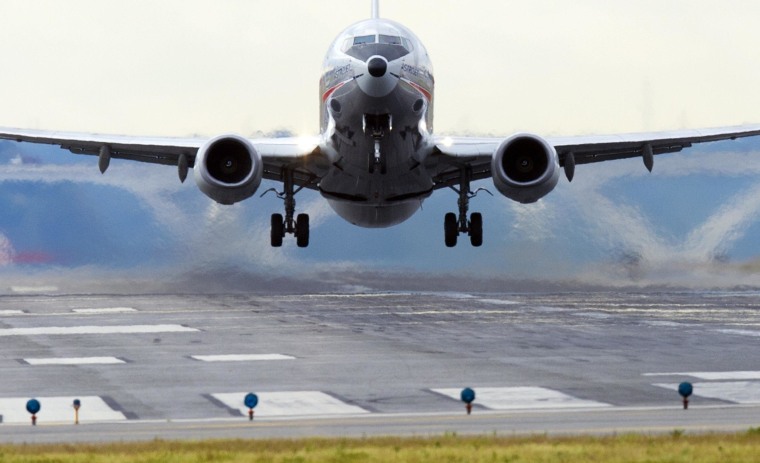Cheap flights are tempting — especially when you're arranging a quick work trip or trying to make the most out of vacay funds. But you may be paying a steep price in other ways.
A new study by The Points Guy ranked the 10 leading domestic U.S airlines from 1 to 10, and found that customers ranked Spirit the "worst" airline. The "ultra low-cost carrier" was found to be the leader in late arrivals, low customer satisfaction, not so comfortable cabins, and a lousy frequent flyer program.
It's no coincidence that Spirit is often the cheapest way to fly, said Julian Mark Kheel, analyst at The Points Guy. What TPG found to be the second cheapest U.S airline, Frontier, landed just ahead of Spirit on the list, the runner-up for the worst.
'You Get What You Pay For'
"The key takeaway is that you get what you pay for," said Kheel. "Spirit leads the pack with low airfare but that leaves them with less to put towards other [factors] like baggage operation."
Here's the full list of the Best and Worst Airlines (with #1 being the best) in the U.S according to TPG, which leveraged data from a number of sources including the Bureau of Transportation Statistics, U.S. Department of Transportation, Routehappy, and others.
1. Alaska Airlines
2. United Airlines
3. Virgin America
4. JetBlue Airways
5. American Airlines
6. Southwest Airlines
7. Delta Air Lines
8. Hawaiian Airlines
9. Frontier Airlines
10. Spirit Airlines
TPG made a point of only using "hard data," Kheel said, and made a list of 10 criteria, then quantified the value of each criteria as follows: airfare (25 percent), route networks (15 percent), bag/change fees (10 percent), cabin comfort (10 percent), customer satisfaction (10 percent), frequent flyer programs (10 percent), on-time arrivals (10 percent), lost baggage (5 percent), domestic lounges (3 percent) and involuntary bumps, aka, overselling seats (2 percent).
Alaska at #1 Is No Surprise — But Delta at #7?
That Alaska Airlines came in at number one was no surprise to Kheel, who said the company is known for being a smooth operator with great perks.
"Alaska's frequent flyer program is the best in the industry," said Kheel. "They have a smaller route network than others, and that did hurt them in our study, but they're in the middle of a merger with Virgin who scored well in third place. That will make Alaska a much bigger airline. If they can maintain their service quality they could end up being a tough competitor to the big three legacy airlines: United, America, Delta."
Related: Meet Delta's First Black Female Captain
That one of those three legacy airlines, Delta, slumped in at number 7, was rather surprising to Kheel.
"Delta has a pretty good reputation for running on time, and not losing luggage, which was true according to the hard data [we looked at]," said Kheel. "The problem with Delta is that in our study, they're the most expensive when it comes to airfare."
What About Your Experience?
TPG may be surprised by Delta's low ranking, but plenty of Delta passengers probably would argue it should be even lower. A quick browse on Twitter shows that, for a variety of reasons, people aren't too impressed with Delta.
But wait, people also are talking trash about Southwest, and United, and hey, even Alaska Airlines.
Keep in mind that customer satisfaction made up just 10 percent of TPG's study. Chances are, at some point or another, every airline is going to disappoint. But they can also delight.
"While I was on a Southwest flight back from Nashville last summer, the flight attendant noticed that it was [two passengers'] birthday on the plane," said Justin Sochovka, a frequent flier and an on-air guest specialist at QVC. "He dimmed the lights on the plane, instructed everyone to turn on their overhead lights to recreate candles and the entire plane came to gather to sing Happy Birthday to the two customers. It was a small gesture that I thought was just the coolest thing."
Even Spirit has its benefits. Seth Kaplan, managing partner at Airline Weekly, opts for Spirit over JetBlue and Southwest — and not only because of low cost.
"There’s a lot about flying Spirit that I don’t like; however, for a rather long flight, the most important thing to me [is] seat comfort," said Kaplan. "And which of those three airlines offers the most comfortable seat? It’s not even a close call: Spirit’s 'big front seats,' which are essentially first-class seats (just without the differentiated service), are more comfortable than any seat on JetBlue or Southwest."
The Value in Customer Feedback
We're all going to have good and probably even more lousy experiences while flying the (inconsistently) friendly skies. And while it may feel like airlines are getting away with whatever they want, paying little to no mind to what consumers have to say, TPG's top three have proven to be fairly receptive to customer feedback.
"Alaska Airlines, United Airlines, and Virgin America are likely higher on the list because they are known for listening to customer feedback," said Susan Ganeshan, CMO of Clarabridge, a customer experience management solution firm. "For example, after receiving consistent complaints on the quality of their in-flight coffee, United completed a system overhaul and transitioned to Italian coffee maker illy, which dramatically improved the passenger experience and reduced complaints."
The airlines hovering at the bottom of TPG's study could learn from paying better attention to their passengers.
"If the airlines that are lower on the list welcome the customer to the executive table, they’ll have happier and more loyal customers, which will ultimately increase the bottom line," said Ganeshan.
So fill out those post-flight surveys even if it feels like a waste of time, and keep calling out airlines on social media.
